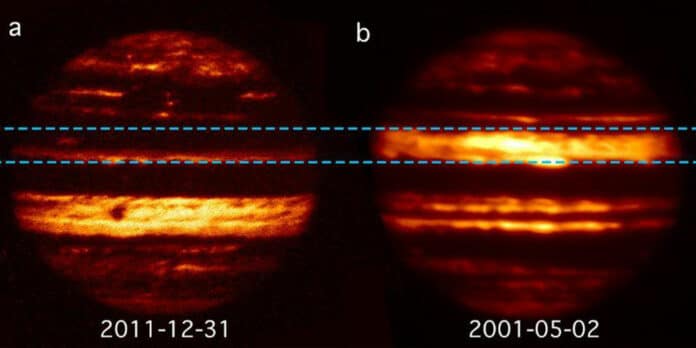Jupiter’s weather layer exhibits long-term and quasi-periodic cycles of meteorological activity that can completely change the appearance of its belts and zones. Although 5-m radiation, which offers a view into the regions of the troposphere that generate clouds, undergoes cycles with intervals of 4 to 9 years, depending on latitude, their origin has remained a mystery.
Academics at the University of Leeds believe they could have found the answer to a long-running mystery behind Jupiter’s famous “stripes.” NASA’s Juno mission made the discovery possible by providing new information about Jupiter’s magnetic field.
Professor Chris Jones from the University’s School of Maths said, “If you look at Jupiter through a telescope, you see the stripes, which go round the equator along the lines of latitude. Dark and light belts occur, and if you look a little bit more closely, you can see clouds zipping around carried by extraordinarily strong easterly and westerly winds. The wind blows eastward near the equator, but as you change latitude a bit, either north or south, it goes westward. And then, if you move a little bit further away, it goes eastward again. This alternating pattern of eastward and westward winds is quite different from weather on Earth.”
This new research has demonstrated that these variations may, in turn, be generated by waves created by the planet’s magnetic field deep within its interior. Scientists already know that the shifting appearance of Jupiter is somehow connected to infrared variations approximately 50 km below the gas giant’s surface.
Their research team was able to track and determine changes in Jupiter’s magnetic field using information acquired by NASA’s Juno spacecraft, which has been orbiting the planet since 2016.
Professor Jones added: “It is possible to get wavelike motions in a planetary magnetic field called torsional oscillations. The exciting thing is that when we calculated the periods of these torsional oscillations, they corresponded to the periods that you see in the infrared radiation on Jupiter.”
Juno has been in orbit for much longer than anticipated, thanks to its incredible durability in Jupiter’s hostile radiation environment. As a result, the Leeds researchers have access to magnetic field data over a significantly longer time span, which is very helpful for their research.
They have been able to follow the magnetic field’s waves and oscillations by observing it over a longer period. They have even traced a particular magnetic field spot on Jupiter, the Great Blue Spot.
Juno has been in orbit for much longer than anticipated, thanks to its incredible durability in Jupiter’s hostile radiation environment. As a result, the Leeds researchers have access to magnetic field data over a significantly longer time span, which is very helpful for their research.
They have been able to follow the magnetic field’s waves and oscillations by observing it over a longer period of time. They have even traced a particular magnetic field spot on Jupiter, the Great Blue Spot.
Dr. Kumiko Hori from the University’s School of Maths said, “There remain uncertainties and questions, particularly how exactly the torsional oscillation produces the observed infrared variation, which likely reflects the complex dynamics and cloud/aerosol reactions. Those need more research. Nonetheless, I hope our paper could also open a window to probe the hidden deep interior of Jupiter, just like seismology does for the Earth and helioseismology does for the Sun.”
“The breakthrough is the culmination of a lifelong passion for Jupiter. I am incredibly pleased that NASA finally managed to get to see Jupiter’s magnetic field in detail. I have been studying Jupiter for an exceptionally long time, and I got interested in what lies below the surface of Jupiter when I was a child – it has been a 60-year progression.”
Journal Reference:
- Hori, K., Jones, C.A., Antuñano, A. et al. Jupiter’s cloud-level variability is triggered by torsional oscillations in the interior. Nat Astron (2023). DOI: 10.1038/s41550-023-01967-1
